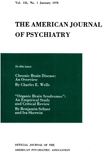Evaluation and diagnosis of persistent insomnia
Abstract
The authors placed 84 patients who complained of insomnia into 10 diagnostic categories on the basis of medical, psychiatric, and polysomnographic evaluations. Only half the patients had objectively defined difficulty inducing or maintaining sleep when compared with 20 normal control subjects. However, all but 16 patients showed polysomnographic evidence of some sleep disorder. Diagnostic categories within the insomnia groups could be distinguished from one another by polysomnography. Patients in only 3 of the 10 diagnostic categories showed evidence of psychological distress on the MMPI; patients in the other 7 categories displayed few psychological symptoms. These results have implications for the treatment of insomnia.
Access content
To read the fulltext, please use one of the options below to sign in or purchase access.- Personal login
- Institutional Login
- Sign in via OpenAthens
- Register for access
-
Please login/register if you wish to pair your device and check access availability.
Not a subscriber?
PsychiatryOnline subscription options offer access to the DSM-5 library, books, journals, CME, and patient resources. This all-in-one virtual library provides psychiatrists and mental health professionals with key resources for diagnosis, treatment, research, and professional development.
Need more help? PsychiatryOnline Customer Service may be reached by emailing [email protected] or by calling 800-368-5777 (in the U.S.) or 703-907-7322 (outside the U.S.).



